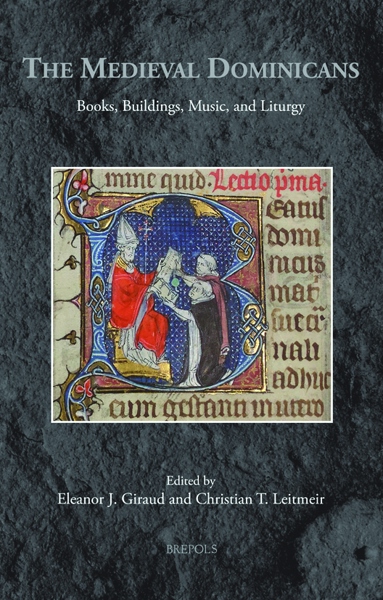
Monastic Communities and Canonical Clergy in the Carolingian World (780–840)
Categorizing the Church
Rutger Kramer, Graeme Ward, Emilie Kurdziel (eds)
- Pages: 454 p.
- Size:156 x 234 mm
- Illustrations:4 b/w
- Language(s):English
- Publication Year:2022
- € 120,00 EXCL. VAT RETAIL PRICE
- ISBN: 978-2-503-57935-1
- Hardback
- Available
- € 120,00 EXCL. VAT RETAIL PRICE
- ISBN: 978-2-503-57936-8
- E-book
- Available
A series of case studies of the 'Carolingian Church Reforms' (816-819) that debated the status of secular and monastic clergy within their respective communities also served to more clearly define the place of bishops, abbots, priests, and monks within the ecclesiastical hierarchy.
“Scholars will find in this solid and rich volume a re-assessment of the goals and the impact of the Carolingian Church Reforms in many respects (…)” (Marco Stoffella, in The Medieval Review, 12/01/2024)
“This important and exceptionally coherent collection of essays presents more than a fresh perspective on the notion of ‘reform’ and the challenges of determining the criteria thereof (…) The contributors represent a heartening new generation of excellent younger scholars, indicating that the future of the study of early medieval Europe is assured.” (ROSAMOND MCKITTERICK, in Journal of Ecclesiastical History, 73, 2022, p. 873-875)
« Cet ouvrage constitue donc un apport très neuf à la question déjà très discutée des transformations de l’Église franque sous les premiers Carolingiens, en critiquant et renouvelant les idées fondatrices de J. Semmler ou d’A. Baumstark. » (Anne Massoni, dans Le Moyen Âge, 130(3-4), 2024, p. 1008)
Rutger Kramer currently works as an assistant professor at the Radboud University Nijmegen and as a lecturer in medieval history at Utrecht University.
Emilie Kurdziel is Maître de conférences in medieval history, Université de Poitiers / CESCM (Centre d’études supérieures de civilisation médiévale).
Graeme Ward is an associate member of the Faculty of History of the University of Oxford.
In the years 816–819, a series of councils was held at the imperial palace in Aachen. The goal of the meetings was to settle a number of questions about ecclesiastical organization. These issues were hotly debated throughout the Christian Roman Empire of the fourth and fifth centuries, and then reinvigorated by the renewal of empire under Charlemagne and his son Louis the Pious. At the centre of the ensuing debate stood the distinction between monks and monastic communities on the one hand, and the so-called clerici canonici and their communities on the other. Many other reforms were proposed in its wake: the position of the episcopacy needed to be renegotiated, the role of the imperial court needed to be consolidated, and the place of every Christian within the renewed Carolingian Church needed to be redefined. What started out as a seemingly straightforward reorganisation of the religious communities that dotted the Frankish ecclesiastical landscape thus quickly turned into a broad movement that necessitated an almost complete categorization of the orders of the Church. The contributions to this volume each zoom in on various aspects of these negotiations: their prehistory, their implementation, and their influence. In doing so, previously held assumptions about the scope, the goals, and the impact of the ‘Carolingian Church Reforms’ will also be re-assessed.
Institutions, Identities, and the Realisation of Reform: An Introduction — RUTGER KRAMER, EMILIE KURDZIEL, and GRAEME WARD
The Monastic Reforms of 816–19: Ideals and Reality — CHARLES MÉRIAUX
Origins
The Organization of the Clergy and the canonici in the Sixth Century — SEBASTIAN SCHOLZ
Choreography and Confession: the Memoriale qualiter and Carolingian Monasticism — ALBRECHT DIEM
Confusion and the Need to Choose? A Fresh Look at the Objectives Behind the Carolingian Reform Efforts in Capitularies and Conciliar Legislation (c. 750–813) — BRIGITTE MEIJNS
Old Norms, New Boundaries
What is a canonicus? The Carolingians and the Rethinking of Ecclesiastical ordines — EMILIE KURDZIEL
Reduce, Reuse, Recycle: Episcopal Self-Reflection and the Use of Church Fathers in the Institutio canonicorum — RUTGER KRAMER AND VERONIKA WIESER
Loose Canonesses? (Non-)Gendered Aspects of the Aachen Institutiones — MICHAEL EBER
Reception and Reflection
‘Superior to Canons, and remaining inferior to Monks’: Monks, Canons and Alcuin’s Third Order — STEPHEN LING
This is a Cleric: Hrabanus Maurus’s De institutione clericorum, Clerical Monks, and the Carolingian Church — CINZIA GRIFONI
The ‘Apostates’ of Saint-Denis: Reforms, Dissent and Carolingian Monasticism — INGRID REMBOLD
Debating the "una regula": Reflections on Monastic Life in Ninth-Century Manuscripts from St Gall — JOHANNA JEBE
Reform in Practice
Monks Pray, Priest Teach, Canons Sing and the Laity Listens: The Regula Benedicti and Conceptual Diversity of Sacred Space in Carolingian Discourse — MIRIAM CZOCK
Cathedral and Monastic: Applying Baumstark’s Categories to the Carolingian Divine Office — RENIE CHOY
Implementing Liturgical Change in Ninth-Century Lyon: Authority, Antiphoners, and Aachen 816 — GRAEME WARD
Ordering the Church in the Ordines Romani — ARTHUR WESTWELL
***
Index




